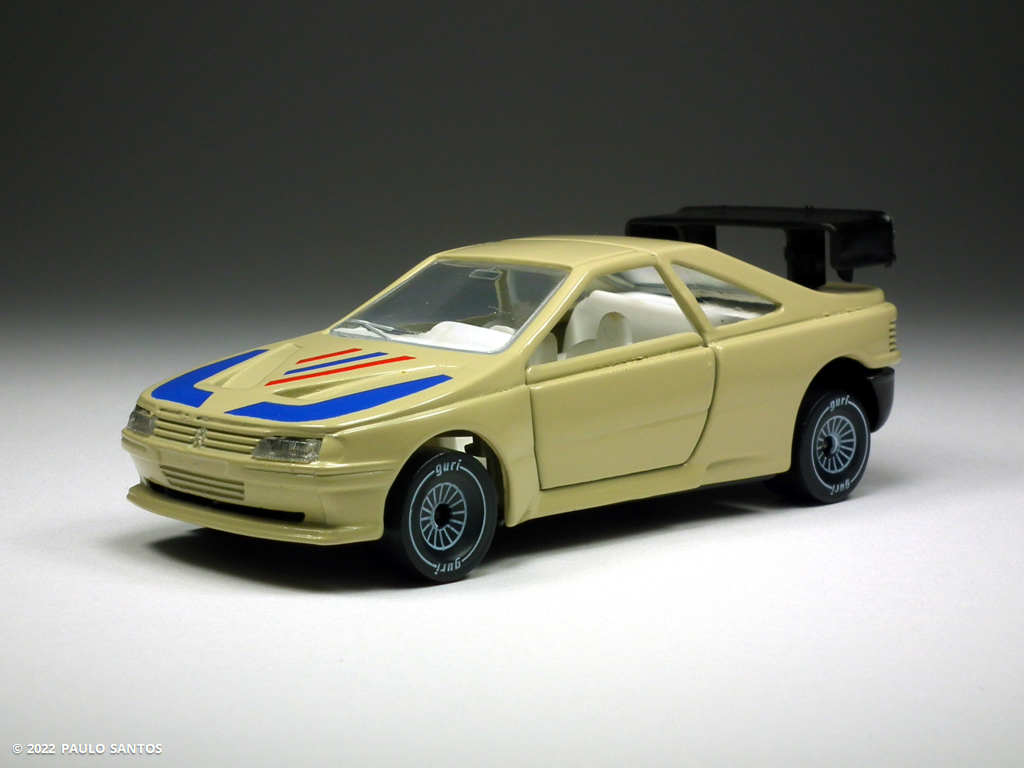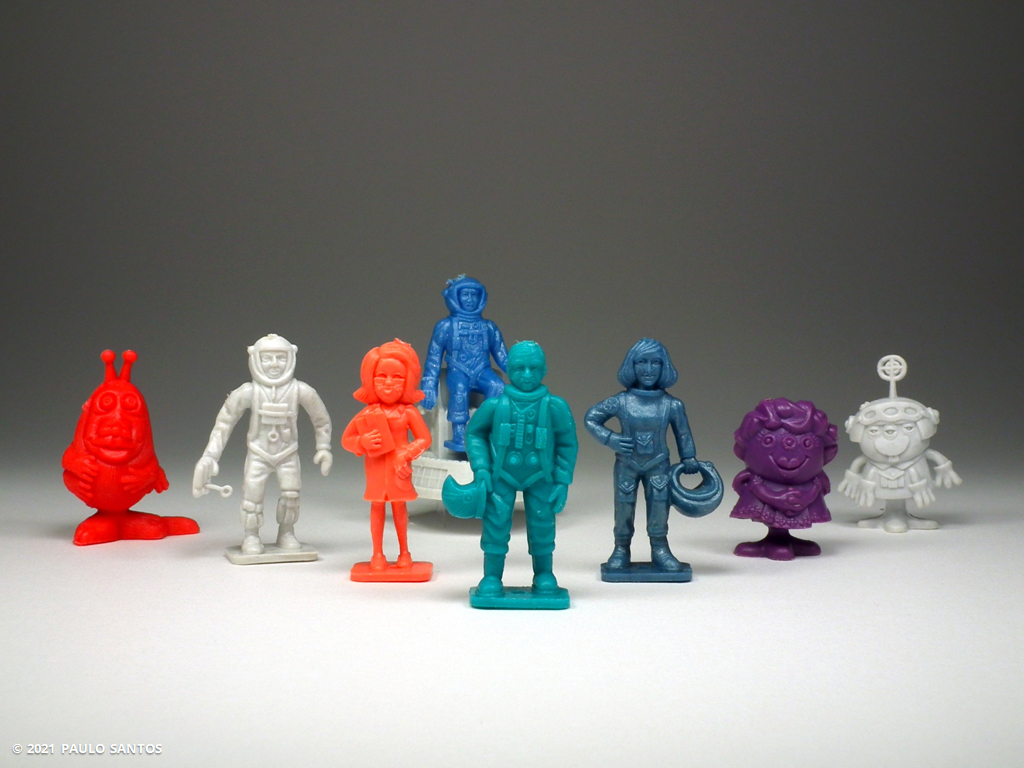Poliguri – Peugeot 405 Prototype
Scale model of a race car, the Peugeot 405 Prototype, made by Poliguri. This example is reference (n/a), included in the "Guri Car" series. It is made in Portugal, possibly between the late 1980s and the mid-1990s. Metal body painted in beige, with printed details on the hood. Rear wing in black plastic. Metal base painted in black. Glazing represented in transparent plastic, with details such as the windshield wipers and the rear-view mirror molded in the windshield. Interior details in white plastic. Plastic wheels (R16) with printed details in white suggesting the rims, white line printed on the tire wall cut twice by the word "Guri". With suspension. Opening doors. The nominal scale is 1:52 and the overall length is approximately 3.1 in. About 1.8 oz. This model represents a race car, the 1987 Peugeot 405 Turbo 16 Group S prototype.
For years I thought that in this model Poliguri had tried to reproduce the Peugeot 405 Turbo 16 "Pikes Peak" – I was wrong. This is actually the much lesser-known Peugeot 405 Turbo 16 Group S prototype, unveiled in 1987. Once again, Poliguri presents us with a well-proportioned and detailed model, featuring clear plastic headlights skillfully integrated into the mold, as well as functional and robust doors. The paint, glossy or satiny depending on the colors, is usually well applied. The reasonably detailed interior features a rear seat, an acceptable compromise given that Poliguri also offers a road version. As in the Fiat Uno, the doors resist, within certain limits, intensive use, but after a few years they stop closing properly, due to the deformation of the sills close to the front fenders. However, in most examples this deformation is not very expressive and almost imperceptible. For all intents and purposes, Poliguri bequeaths us the only "3-inches" model of this Group S prototype ¹, whose circumstantial evolution would leave an amazing mark on African deserts – as well as on a certain American hill climb. This automobile, the Peugeot 405 Prototype, is in my collection under the themes "French Vehicles", "Concept Cars" and "Race Cars". ●
Modelo à escala de um carro de corrida, o Peugeot 405 Prototype, feito pela Poliguri. Este exemplar é a referência (n/d), incluída na série "Guri Car". É feito em Portugal, possivelmente entre o final dos anos oitenta e meados dos anos noventa. Carroçaria em metal pintada em beje, com detalhes impressos no "capot". Asa traseira em plástico preto. Base em metal pintada em preto. Vidros representados em plástico transparente com detalhes como os limpa pára-brisas e o espelho retrovisor moldados no pára-brisas. Detalhes interiores em plástico branco. Rodas em plástico (R16) com detalhes impressos em branco a sugerir as jantes, linha branca impressa na parede do pneu cortada duas vezes pela palavra "Guri". Com suspensão. Abre as portas. A escala nominal é 1:52 e o comprimento total é de aproximadamente 78 mm. Cerca de 50 g. Este modelo representa um carro de corrida, baseado no o protótipo Peugeot 405 Turbo 16 Grupo S de 1987.
Durante anos, pensei que neste modelo a Poliguri tentara reproduzir o Peugeot 405 Turbo 16 "Pikes Peak" – estava errado. Este é na realidade o muito menos conhecido protótipo Peugeot 405 Turbo 16 Group S, revelado em 1987. Mais uma vez, a Poliguri apresenta-nos um modelo bem proporcionado e detalhado, exibindo faróis em plástico transparente habilmente integrados no molde, assim como as portas funcionais e robustas. A pintura, brilhante ou acetinada consoante as cores, é geralmente bem aplicada. O interior, razoavelmente detalhado, possui um banco traseiro, um compromisso aceitável dado que a Poliguri tambem oferece uma versão de estrada. Tal como no Fiat Uno, as portas resistem, dentro de certos limites, ao uso intensivo, mas ao fim de alguns anos deixam de fechar correctamente, pela deformação das embaladeiras junto aos pára-lamas dianteiros. Todavia, na maioria dos exemplares esta deformação é pouco expressiva e quase imperceptível. Para todos os efeitos, a Poliguri lega-nos o único modelo "3-inches" deste protótipo do Grupo S ¹, cuja circunstancial evolução deixaria uma espantosa marca nos desertos Africanos – assim como numa certa rampa Americana. Este automóvel, o Peugeot 405 Prototype, encontra-se na minha colecção sob os temas "Veículos Franceses", "Concept Cars" e "Carros de Corrida". ●
¹ Group S would succeed Group B in 1988, in an attempt to limit the dangerous evolution of performance, especially in terms of the speeds reached. If Group B had not been abruptly canceled in 1986, this 405 T16 would certainly have been, after the fearsome 205 T16, yet another entry by Peugeot into this league of giants. ● O Grupo S iria em 1988 suceder ao Grupo B, numa tentativa de limitar a perigosa evolução de desempenho dos carros, sobretudo ao nível das velocidades atingidas. Se o Grupo B não tivesse sido bruscamente cancelado em 1986, este 405 T16 seria decerto, depois do temível 205 T16, mais uma entrada da Peugeot nesta liga de gigantes.
Poliguri "Guri Car" series
The "Guri Car" series comprises at least 14 references, including the Unimog, several versions of the Mercedes-Benz TN, the Mercedes-Benz 200, the Fiat Uno and the Peugeot 405 Prototype. Check out these Poliguri references here. ● A série "Guri Car" compreende pelo menos 14 referências, incluindo o Unimog, diversas versões da Mercedes-Benz TN, o Mercedes-Benz 200, o Fiat Uno e o Peugeot 405 Prototype. Confira aqui estas referências da Poliguri.
|
Item |
Reference |
Scale |
Made |
|
Peugeot
405 Prototype Race Car |
714? [4] |
1:52 |
1980s |
[4] No reference number known.
Versions and color variants
Reference available in several colors and decorations. White, black or red interiors. Fitted with R16 wheels. Necessary corrections or additions to the above are welcome. ●
Referência disponível em várias cores e decorações. Interiores em branco, preto ou vermelho. Equipada com rodas R16. Devidas correcções ou adições ao acima descrito são bem-vindas. ●
(n/a) White w/ printed details on the roof, hood and sides, red interior, black wing.


(n/a) Blue w/ printed details on the roof, hood and sides, white interior, white wing.
Below Despite its short lineup, presumably 14 references based on 10 models, Poliguri poses a challenge for variant collectors, especially with the Mercedes 200, Fiat Uno and Peugeot 405 Prototype models. So far, I haven't met anyone who knows for sure how many variants there are – but the numbers must be staggering. In the image, an idea of the challenge, part of the collection of an Austrian enthusiast of Peugeot models. ● Em baixo Apesar da sua gama curta, presumivelmente 14 referências baseadas em 10 modelos, a Poliguri constitui um desafio para os coleccionadores de variantes, sobretudo com os modelos Mercedes 200, Fiat Uno e Peugeot 405 Prototype. Até hoje, não conheci ninguém que saiba ao certo a quantidade de variantes – mas os números devem ser assombrosos. Na imagem, uma ideia do desafio, parte do acervo de um entusiasta Austríaco de modelos Peugeot.
How much?
Several readers have asked me to include the market value of the items described. In fact, and as most collectors will agree – an item is worth what someone is willing to pay for it. However, most collectors will also agree on average values, based on objective notions of relevance, scarcity and conservation. Therefore, and as I know that these requests for market values will not stop, I will occasionally include, not necessarily the market value, but rather, based on my perception of the markets over the last thirty years, the value that, hypothetically and at the time of publication, I am willing to pay for the item described. In this case, I will pay up to €7 for a Peugeot 405 Prototype by Poliguri, loose and in good condition, or up to €12 if boxed and in perfect condition. ●
Vários leitores têm-me pedido para incluir o valor de mercado dos itens descritos. De facto, e como a maioria dos coleccionadores concordará – um item vale o que alguém está disposto a pagar por ele. No entanto, a maioria dos coleccionadores também concordará com valores médios, baseados em noções objectivas de relevância, de escassez e de conservação. Assim sendo, e como sei que esses pedidos por valores de mercado não vão parar, passo a incluir ocasionalmente, não forçosamente o valor de mercado, mas sim, e baseado na minha percepção dos mercados ao longo dos últimos trinta anos, o valor que, hipoteticamente e no momento da publicação, estou disposto a pagar pelo item descrito. Neste caso, pagarei até 7 € por um Peugeot 405 Prototype da Poliguri, avulso e em bom estado, ou até 12 € se estiver na caixa em perfeito estado. ●
Below, two images originally published on the website "MY POLIGURI COLLECTION". The third image was also shot in 2015, but not published. | Abaixo, duas imagens originalmente publicadas no website "MY POLIGURI COLLECTION". A terceira imagem foi igualmente obtida em 2015, mas não publicada.
● References
Tales of Toy Cars | "Portugal Presents Poliguri"
AutoModellando | "Poliguri – Breve storia di un piccolo marchio"
Toys from the Past | "#132 POLIGURI – PEUGEOT 405 TURBO 16 and MERCEDES 200 (1988)"
MY POLIGURI COLLECTION | "Brief Introduction to Poliguri"
MY POLIGURI COLLECTION | "Breve Introdução à Poliguri"
MY POLIGURI COLLECTION | "Poliguri – Types of Wheels"
Group B Shrine | "Peugeot 405 Turbo 16 Grupo S Prototype"
Group B Shrine | "Group S – the stillborn successor"
Wikipedia | "Pikes Peak International Hill Climb"
1 mm → 0.039 in
1 g → 0.035 oz
1 kW → 1,360 hp (metric)
1 kW → 1,341 hp
1 hp (metric/PS) → 0,986 hp
1 km → 0,621 mile (international)
● How does a "real" Peugeot 405 T16 Prototype looks and sounds like? Sadly, I didn't find any video review of this prototype. But check it here, the Peugeot 405 T16 PP, masterfully driven by Ari Vatanen on an epic "Pikes Peak" hill climb. Video retrieved from TestDrivenUK.














Comments
Post a Comment